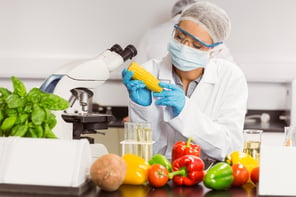
The amount of pesticides used agriculturally since the 1950's has more than tippled.
The most common food contaminants are persistent organic pollutants (POPs), organophosphate and pyrethroid pesticides, plasticizers, bisphenol A and metals. The USDA and FDA both have compiled lists that describe the toxicant content in typical food consumed in the United States.
POPs include polychlorinated biphenyls, organochlorine pesticides and brominated flame retardants. Residues were found in meat, poultry and dairy products as well as baked goods, fruits and vegetables.
Polychlorinated Biphenyls and Organochlorine Pesticides were found in 100% of salmon samples, with farmed salmon being the cause of 97% of POP exposure. PCP content in farmed salmon averaged 42.5 ng/g as apposed to wild Alaskan salmon with only 3.2 ng/g.
Persistent polybrominated diphenyl ethers (PBDEs), typically used as flame retardants are found to be highest in fish, meats and dairy products. Sardines topped the charts, but high levels were also found in farmed salmon, pork sausage and hot dogs. Hot dogs were found to range in levels from one in the sample containing 195 pg/g where another had a startling 1426 pg/g.
Glyphosate, solvents, plasticizers and BPA are also found in packaged foods. Solvents are found in Styrofoam food containers and microwave safe containers. Plasticizers can contaminate food from simple contact with plastic wrap. Plastic migration increases with the fat content of the food, time in contact and temperature. Contamination can also come from the wearing disposable polyvinylchloride gloves to prepare food. Bisphenol A or BPA is found in canned food and beverages. The daily intake of BPA by US residents is estimated at 12.6 ng/kg/day. The consumption of one canned item can increase daily urinary BPA by 24%!
Heavy metals are also found in our food supply. Aluminum is present in some processed foods and arsenic has been found in fish, rice and poultry. Cadmium is present in tofu made from conventionally grown soy beans and sunflower seeds. And of course, mercury, in fish.
What can you do? Well it is important to try to consume organic foods when possible, to wash food in acid or alkaline solution and peeling. Peeling potatoes was shown to reduce pesticide content by at least 70%.
If you think that pesticide and chemical consumption in food could be causing some of your symptoms, let us figure out your total body burden. With our new telehealth program we can discover your total body burden no matter where you are located in the United States. Utilizing our toxicity quiz and exposure questionnaire we can determine if you are consuming foods high in pollutants that might be the key to to your body burden.


